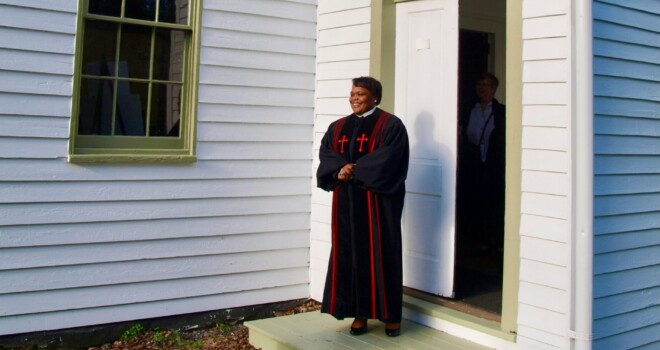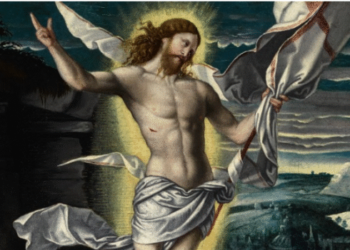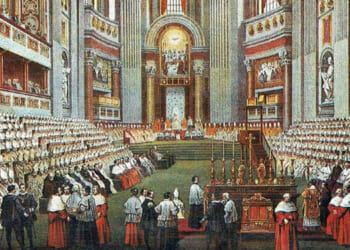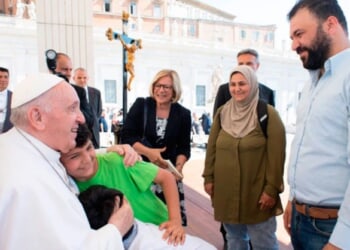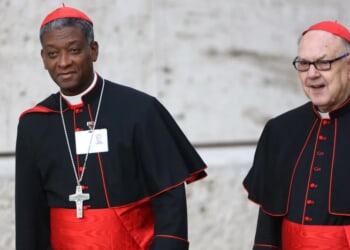Franciscan friars from Germany came to my hometown, Quincy, IL, in 1858 and started St. Francis parish, a hospital, and a school, which is now Quincy University. My two priest uncles went there in the 1940s. The priest whose chalice I use for Mass went there in the 1920s.
After serving in Quincy for 160 years, the Franciscans pulled out of the city in 2019. Their province leader told the Quincy Herald Whig paper that “it stems from a decline in men entering the ministry.” In other words, the Franciscans did not have any vocations.
About this time, I was home visiting my mother, and there was a bulletin on her table from St. Francis parish, brought over by my sister who attends early morning Mass. Inside the bulletin in big black font was the phrase “Pray for Vocations.” Directly above the phrase was the liturgical minister assignments for the weekend Masses. In the “Altar Server” column, there was 1 boy and 11 girls. In the “Communion Ministers” column, there were 5 men and 25 women. The column for “Greeter” contained 1 man and 7 women.
The parish was told to pray for priests while its sanctuary was flooded with women and girls. Is it any wonder that the Franciscans have a vocation problem?
And it’s not just the Franciscans. In most parishes today, the women far outnumber the men, not only in the pews, but in liturgical roles. This is slowly reversing in many places, and St. Francis parish has a younger diocesan priest who appears to be chipping away at the role reversal problem, but it’s hard to turn around a train.
For context, one must understand that, for almost 2000 years, only the male sex entered the sanctuary at Mass. On January 29, 1973, one week after abortion was greenlit in the US, the Vatican greenlit the idea of allowing lay communion ministers in extraordinary circumstances. It also allowed lay readers which, for the first time in Catholic history, included women. In 1994, Pope John Paul II allowed, also for the first time in Catholic history, female altar servers. A month after he did so, Pope John Paul declared that women could not be priests because the Church does not have the authority to ordain them.
The push for their ordination continues nonetheless.
A scholar observed:
In the Latin-rite Church, by inviting females to serve at the place of priestly sacrifice, dressed in the priestly garb of alb or cassock, gives the impression of speaking with a forked tongue. At the level of her purely verbal communication the Church promulgates documents asserting clearly that women can never be priests; but in her “body language” as it were, namely, in her most sacred liturgical action, she now seems to be insinuating the exact opposite.
And during all of this, vocations to the priesthood have been decimated.
One of the greatest fears of a man (young or old) is to have his manhood called into question. That can and does happen when men find themselves participating in activities that are deemed overly “womanly.”
At most parishes this weekend, a man’s wife, mother, daughter, grandma, and aunt are up on the sanctuary “feeding” the sheep, which is what in effect the men have become—and not just sheep, but lost sheep—which has produced a lost culture. A true Christian culture, a scholar wrote, produces a Christian gentleman. It produces a Christian knight, someone who can mind his manners at a dinner table. But it is also a man who gets vicious when the occasion calls for it.
Christ was and is a man. He was and is the Bridegroom. Christ gives, and His bride the Church receives. Christ is male, and the Church is female. If it were not this way, then there would be no lifegiving union between the two. Think of a plumber. He uses male fittings and female fittings which complement each other; they fit together. It has to be that way, otherwise water and sewage would spew everywhere. Just as there is no union between two male plumbing parts, there is no life-giving union between two bridegrooms. There is no union between two brides. Those unnatural pairings are only simulations of unions. They are counterfeit.
What takes place at Mass is the most intimate thing one could ever imagine because it involves a union with God that is both mystical and physical. But, once again, for this union to take place, Christ has to be the Priest and Bridegroom. It is He who initiates the union. It is He who gives, who plants the seed.
At this point, men might be thinking, “Is Father making me out to be a bride, a woman in this scenario?” Of course not. A scholar wrote:
Christ is a man, a priest, a bridegroom; this is no mere metaphor, but a fact of the natural and supernatural orders. The Christian is like a woman, a mother, a bride; this is a metaphor of a certain fundamental spiritual identity and vocation.
A catcher on the baseball team receives the pitch. In that instance, due to the receptive nature of his action he is like a woman. But he is not a woman. And neither is Christ. Those are facts. The sacred liturgy must take into account both facts and metaphors, in a coherent synthesis—and this is precisely what Catholics have had in their theological and liturgical tradition until the confusion of the last few decades.
The confusion is the result of an ideological push for a gender-bending theology and a sex-less liturgy where male and female parts are interchangeable. And what has it produced? A devastated vineyard, barren and sterile. How could it be otherwise? For the parts don’t fit together. The complementarity has vanished. And as a result, we are surrounded by spiritual sewage.
In Sunday’s first reading, we can see the government of the Church put in play by Christ. It is hierarchal and patriarchal. What does our modern world say about that? It says Christ and His disciples were sexist (a term coined in the 1960s). It says they were products of their backward, unenlightened culture. But that is simply not true. Christ’s Church was and is a radical, revolutionary thing that belongs to no culture and no time because it is not a man-made organization.
Man-made organizations do not save anyone. When we understand that Christ is not a mere president or chairman of the board, but the Priest who offers Himself for our salvation, then we will no longer look up at the sanctuary and see only discrimination and a civil rights battleground. Instead of a glass ceiling, we will see a sea of glass and the holy city Jerusalem coming from heaven.
When that happens, we will naturally get vocations to the priesthood. We will get laborers for the vineyard and fishers of men to stand in for Christ at His altar of sacrifice. We will get men of God, meek and humble of heart—who will become vicious in their defense of Christ’s bride, when the occasion calls for it.
Photo by Diane Helentjaris on Unsplash

